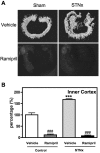Reduction in renal ACE2 expression in subtotal nephrectomy in rats is ameliorated with ACE inhibition
- PMID: 19698082
- PMCID: PMC2782317
- DOI: 10.1042/CS20090318
Reduction in renal ACE2 expression in subtotal nephrectomy in rats is ameliorated with ACE inhibition
Abstract
Alterations within the RAS (renin-angiotensin system) are pivotal for the development of renal disease. ACE2 (angiotensin-converting enzyme 2) is expressed in the kidney and converts the vasoconstrictor AngII (angiotensin II) into Ang-(1-7), a peptide with vasodilatory and anti-fibrotic actions. Although the expression of ACE2 in the diabetic kidney has been well studied, little is known about its expression in non-diabetic renal disease. In the present study, we assessed ACE2 in rats with acute kidney injury induced by STNx (subtotal nephrectomy). STNx and Control rats received vehicle or ramipril (1 mg. kg (-1) of body weight . day (-1), and renal ACE, ACE2 and mas receptor gene and protein expression were measured 10 days later. STNx rats were characterized by polyuria, proteinuria, hypertension and elevated plasma ACE2 activity (all P<0.01) and plasma Ang-(1-7) (P<0.05) compared with Control rats. There was increased cortical ACE binding and medullary mas receptor expression (P<0.05), but reduced cortical and medullary ACE2 activity in the remnant kidney (P<0.05 and P<0.001 respectively) compared with Control rats. In STNx rats, ramipril reduced blood pressure (P<0.01), polyuria (P<0.05)and plasma ACE2 (P<0.01), increased plasma Ang-(1-7) (P<0.001), and inhibited renal ACE(P<0.001). Ramipril increased both cortical and medullary ACE2 activity (P<0.01), but reduced medullary mas receptor expression (P<0.05). In conclusion, our results show that ACE2 activity is reduced in kidney injury and that ACE inhibition produced beneficial effects in association with increased renal ACE2 activity. As ACE2 both degrades AngII and generates the vasodilator Ang-(1-7), a decrease in renal ACE2 activity, as observed in the present study, has the potential to contribute to the progression of kidney disease.
Figures





References
-
- Cooper M. E., Johnston C. I. Optimizing treatment of hypertension in patients with diabetes. JAMA, J. Am. Med. Assoc. 2000;283:3177–3179. - PubMed
-
- Velez J. C. The importance of the intrarenal renin-angiotensin system. Nat. Clin. Pract. Nephrol. 2008;2:89–100. - PubMed
-
- Donoghue M., Hsieh F., Baronas E., Godbout K., Gosselin M., Stagliano N., Donovan M., Woolf B., Robison K., Jeyaseelan R., et al. A novel angiotensin-converting enzyme-related carboxypeptidase (ACE2) converts angiotensin I to angiotensin 1–9. Circ. Res. 2000;87:E1–E9. - PubMed
-
- Tipnis S. R., Hooper N. M., Hyde R., Karran E., Christie G., Turner A. J. A human homolog of angiotensin-converting enzyme: cloning and functional expression as a captopril-insensitive carboxypeptidase. J. Biol. Chem. 2000;275:33238–33243. - PubMed
Publication types
MeSH terms
Substances
LinkOut - more resources
Full Text Sources
Molecular Biology Databases
Research Materials
Miscellaneous

